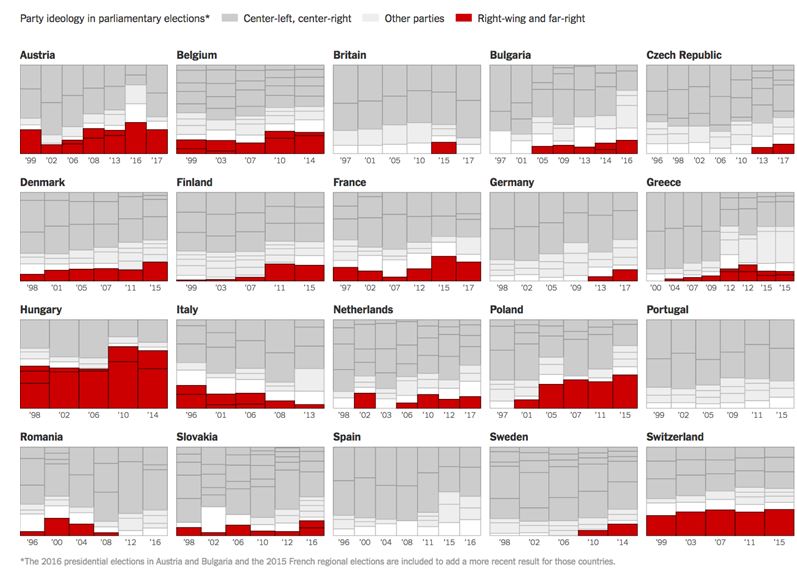Member States ready to dismantle the EU
For several years, in the fight between the national and the European levels of governance, it was asserted that the European level was a bulwark against nationalist ‘populisms’, a bastion of values like peace, openness, tolerance and human progress against the bestiality and war inherent in the national model. However, the reality has started to contradict this certainty, and what we have seen as a development in national politics in recent years is actually not so frightening. True, far-right forces score around 20% in many countries, but that still leaves 80% of opinions very resistant to reactionary and xenophobic parties… And this, despite the huge shocks received by the continent in the past ten years (the country with the highest right-wing voting scores is neither Poland (25%), nor Austria (25%), nor France (21%), nor Hungary (20%), but the wealthy and extra-EU Switzerland (27%)![1]).

Figure – European scores of the far-right by year. Source: New York Times.
France and the Netherlands, who were both proclaimed as the next victims of the far-right wave did not falter. When parliaments radicalise on the right, it is in the context of a right-wing alliance where traditional right-wing parties radicalise more than the citizens. Italy provides a very good example of this situation, where a centre-right Berlusconi made the choice to betray the values of his camp in an alliance with a League on the far-right… all that for a score of 14%. Certainly, this 14%, combined with Salvini’s measly 17% (even Marine Le Pen did better than this), created an illusion that allowed the media to rail against the Italians turning fascist again[2]. In reality, the Italians voted enthusiastically for the 5-stars (32%), a party certainly Euro-critical (but not anti-European), young and innovative, and in no way xenophobic[3]… despite the fact that Italy was at the forefront of the countries affected by the migrant crisis. It is also time to wonder why the establishment (with the media as its faithful mirror) is so eager to show the citizens of Europe as such dreadful racists…
Another example of this sad media habit of downgrading citizen votes comes from Austria, where regional elections were held in which Carinthia re-elected the left wing when it is the home of the FPÖ’s Haider. Instead of welcoming the sustainability of the swing towards the centre in the Carinthian vote, the media preferred to advertise the FPÖ’s Carinthian origins[4]… Elections come and go, depoliticised institutional parties pass away, but our national democracies hold on in the end. The big danger, now, is the one we have long anticipated, namely that the European Parliament falls into the hands of the anti-democratic forces in 2019:
- Because these forces have made progress at the national level
- But, mostly, because they may be the only ones to mobilise citizens in elections whose participation scores constantly decline[5]
This prospect provokes a complete reversal of the roles the European and national levels of governance in terms of who’s the ‘bastion of values’. Therefore, the Member States are entitled to worry about such a risk and to prepare the famous dismantling operation (if necessary) of the Brussels system we see being set up throughout 2018… (fragment – GEAB 123 / March 2018)
_____________________________________________
[1] Source: Le Figaro, 2018. If we take out the gamecard of this year which puts Italy in bright red dishonestly indicating 50.3% of right-wing vote, this infographic of the Figaro shows that the European countries have certainly hardened their opinions but have not yet tilted to the other side.
[2] It is important to look at the real results of the Italian election. Source: Wikipedia
[3] After some research, we still find articles giving a fairer view on the 5-star movement: “Finally, the Movimento Cinque Stelle today is neither a far-left party nor a far right one, as believed. It is, in a way, the heir of Christian Democracy in the age of the Internet”. Source: Le Grand Continent, 10/03/2018
[4] Source: Deutsche Welle, 04/03/2018
[5] From 62% in 1979 to 43% in 2014. Source: Wikipedia




Comments